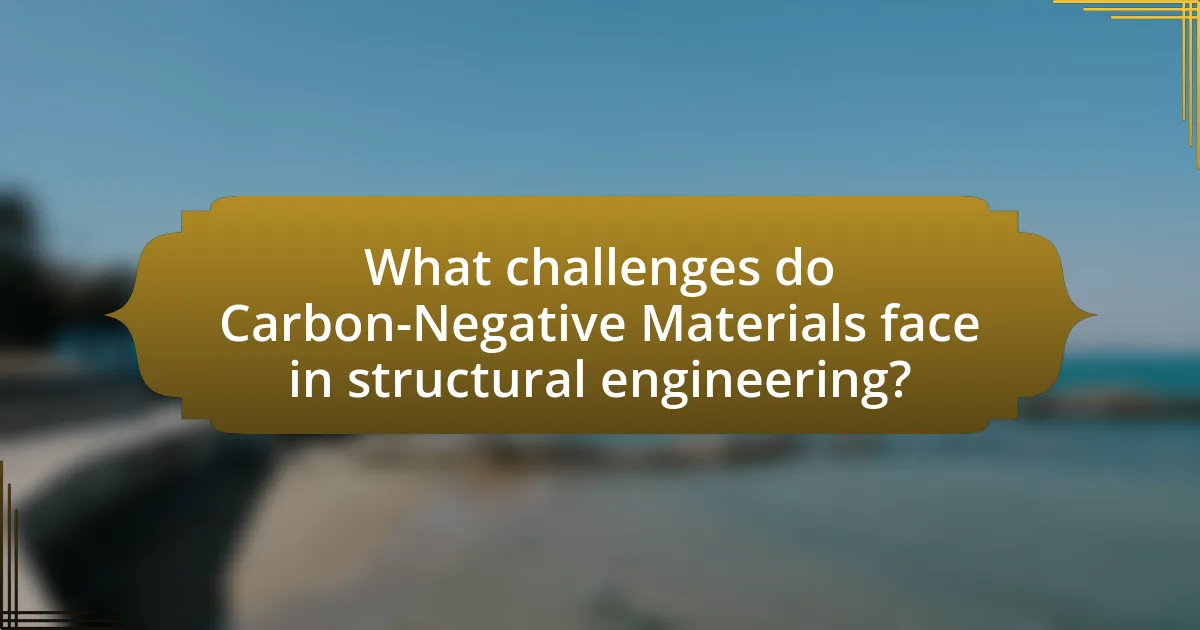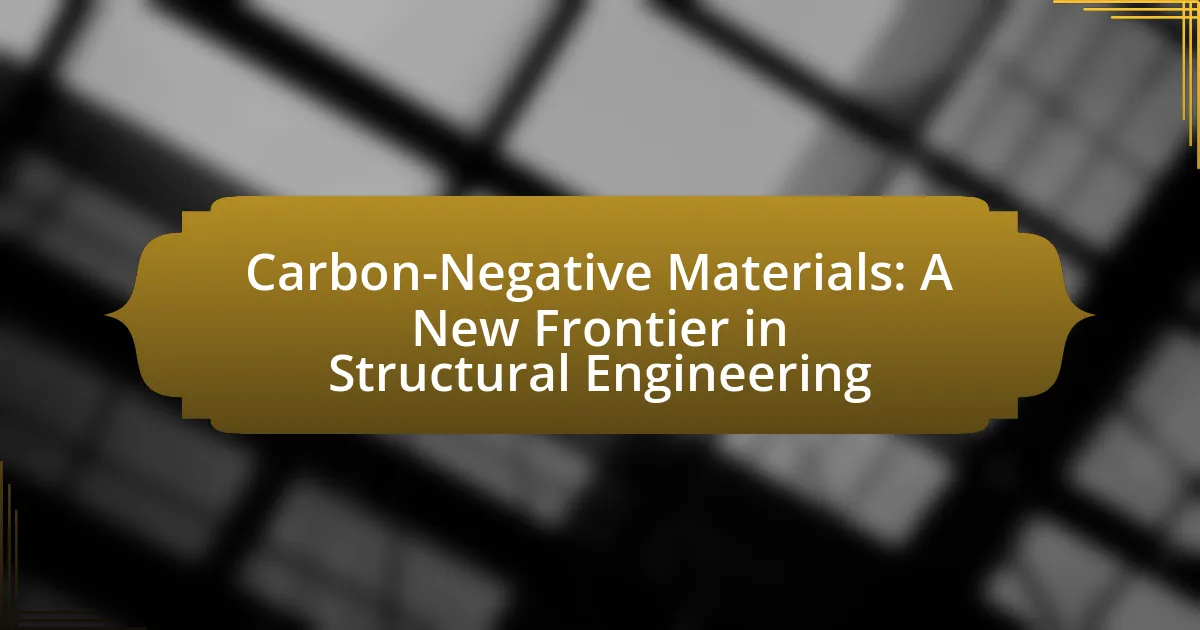Carbon-negative materials are substances that absorb more carbon dioxide than they emit throughout their lifecycle, playing a crucial role in mitigating climate change. This article explores the characteristics of carbon-negative materials, such as biochar and hempcrete, and how they differ from traditional materials like concrete and steel, which contribute significantly to greenhouse gas emissions. It discusses the processes that enable these materials to sequester carbon, their applications in sustainable construction, and the challenges they face in terms of performance, cost, and regulatory acceptance. Additionally, the article highlights the importance of developing carbon-negative materials for achieving sustainability in structural engineering and outlines future trends and best practices for their implementation.

What are Carbon-Negative Materials?
Carbon-negative materials are substances that absorb more carbon dioxide from the atmosphere than they emit during their lifecycle. These materials contribute to reducing greenhouse gas concentrations, thus playing a significant role in combating climate change. For instance, bio-based materials like hempcrete and certain types of engineered wood can sequester carbon as they grow and continue to do so even after being processed into building materials. Research indicates that using carbon-negative materials in construction can lead to a net reduction in carbon emissions, making them a vital component in sustainable structural engineering practices.
How do Carbon-Negative Materials differ from traditional materials?
Carbon-negative materials differ from traditional materials primarily in their ability to absorb more carbon dioxide from the atmosphere than is emitted during their production and use. Traditional materials, such as concrete and steel, typically release significant amounts of carbon dioxide during manufacturing processes, contributing to greenhouse gas emissions. In contrast, carbon-negative materials, like certain bio-based composites and innovative concrete formulations, utilize processes that sequester carbon, thereby reducing overall atmospheric carbon levels. For example, research has shown that biochar, a carbon-negative material, can sequester carbon for hundreds to thousands of years, while traditional concrete contributes approximately 8% of global CO2 emissions. This fundamental difference positions carbon-negative materials as a sustainable alternative in structural engineering, aiming to mitigate climate change impacts.
What processes contribute to the carbon-negative status of these materials?
The processes that contribute to the carbon-negative status of carbon-negative materials include carbon sequestration, the use of renewable resources, and energy-efficient production methods. Carbon sequestration involves capturing and storing atmospheric carbon dioxide during the material’s lifecycle, effectively reducing net carbon emissions. The utilization of renewable resources, such as bio-based materials, ensures that the production process does not rely on fossil fuels, further decreasing carbon footprints. Additionally, energy-efficient production methods minimize energy consumption and associated greenhouse gas emissions, reinforcing the carbon-negative profile of these materials. For instance, studies have shown that materials like hempcrete can sequester more carbon than is emitted during their production and use, demonstrating the effectiveness of these processes in achieving a carbon-negative status.
What types of materials are considered carbon-negative?
Carbon-negative materials include biochar, hempcrete, and certain types of timber, which sequester more carbon dioxide during their lifecycle than they emit. Biochar, produced from organic materials through pyrolysis, can store carbon for centuries while improving soil health. Hempcrete, made from hemp fibers and lime, not only captures carbon during its growth but also continues to sequester it as a building material. Additionally, sustainably sourced timber, when managed properly, can act as a carbon sink, absorbing CO2 from the atmosphere throughout its growth and even after being processed into products. These materials contribute to reducing overall carbon emissions in construction and other industries.
Why is the development of Carbon-Negative Materials important?
The development of carbon-negative materials is important because it directly addresses climate change by reducing atmospheric carbon dioxide levels. These materials not only sequester carbon during their lifecycle but also contribute to sustainable construction practices. For instance, research indicates that carbon-negative concrete can absorb more CO2 than is emitted during its production, potentially offsetting significant greenhouse gas emissions in the construction industry. This innovation aligns with global efforts to achieve net-zero emissions and promotes a circular economy, making it a critical advancement in structural engineering.
What environmental challenges do Carbon-Negative Materials address?
Carbon-negative materials address several critical environmental challenges, primarily climate change and carbon emissions. By sequestering more carbon dioxide than they emit during their lifecycle, these materials help mitigate the greenhouse effect, which is a leading cause of global warming. For instance, research indicates that the production and use of carbon-negative materials can significantly reduce the carbon footprint of construction, with some materials capable of capturing and storing up to 1.1 billion tons of CO2 annually. This capability directly counters the rising levels of atmospheric CO2, contributing to a more sustainable future.
How do Carbon-Negative Materials contribute to sustainability in construction?
Carbon-negative materials contribute to sustainability in construction by absorbing more carbon dioxide during their lifecycle than they emit. This characteristic helps mitigate climate change by reducing the overall carbon footprint of building projects. For instance, materials like hempcrete and certain types of bio-based composites sequester carbon through their growth processes and can continue to store carbon even after being used in construction. Research indicates that using carbon-negative materials can lead to a significant reduction in greenhouse gas emissions, with some studies showing potential reductions of up to 50% compared to traditional materials.
What are the potential applications of Carbon-Negative Materials in structural engineering?
Carbon-negative materials have significant potential applications in structural engineering, primarily in the construction of buildings, infrastructure, and transportation systems. These materials can be utilized in concrete production, where they can replace traditional cement, thereby reducing carbon emissions associated with construction. For instance, research indicates that using carbon-capturing technologies in concrete can lower the carbon footprint by up to 70%. Additionally, carbon-negative materials can be employed in the creation of insulation products, which enhance energy efficiency in buildings, further contributing to reduced greenhouse gas emissions over the lifecycle of the structure. Furthermore, these materials can be integrated into prefabricated components, allowing for quicker assembly and reduced waste on construction sites.
How can Carbon-Negative Materials be integrated into existing construction practices?
Carbon-negative materials can be integrated into existing construction practices by incorporating them into the design and material selection phases of building projects. This integration involves using materials such as bio-based composites, carbon-sequestering concrete, and recycled materials that actively reduce carbon emissions during their lifecycle. For instance, the use of hempcrete, which sequesters carbon dioxide, can replace traditional concrete in non-structural applications, thereby lowering the overall carbon footprint of a building. Additionally, adopting building codes and standards that encourage or mandate the use of carbon-negative materials can facilitate their widespread adoption. Research indicates that implementing these materials can lead to a significant reduction in greenhouse gas emissions, aligning with global sustainability goals.
What innovative projects have successfully utilized Carbon-Negative Materials?
Innovative projects that have successfully utilized carbon-negative materials include the construction of the Bosco Verticale in Milan, Italy, which incorporates bio-based materials that sequester carbon. Another example is the use of hempcrete in various building projects, which not only provides insulation but also captures carbon dioxide during its growth. Additionally, the CarbonCure technology, implemented in concrete production, injects recycled CO2 into concrete, resulting in a carbon-negative product. These projects demonstrate the effective application of carbon-negative materials in structural engineering, contributing to sustainability and carbon reduction efforts.

What challenges do Carbon-Negative Materials face in structural engineering?
Carbon-negative materials face several challenges in structural engineering, primarily related to performance, cost, and regulatory acceptance. Performance issues include the need for these materials to meet or exceed the mechanical properties of traditional materials, such as strength and durability, which are critical for structural applications. Cost challenges arise from the current production processes, which can be more expensive than conventional materials, limiting widespread adoption. Regulatory acceptance is another significant hurdle, as building codes and standards may not yet accommodate innovative materials, requiring extensive testing and validation to ensure safety and compliance. These challenges must be addressed to facilitate the integration of carbon-negative materials into mainstream structural engineering practices.
What are the technical limitations of Carbon-Negative Materials?
The technical limitations of carbon-negative materials include challenges related to scalability, material performance, and cost-effectiveness. Scalability issues arise because many carbon-negative materials are still in the experimental phase, making large-scale production difficult. Performance limitations can manifest in reduced mechanical strength or durability compared to traditional materials, which may hinder their application in structural engineering. Additionally, the cost of producing carbon-negative materials can be higher than conventional options, limiting their widespread adoption. For instance, research indicates that while bio-based composites can sequester carbon, their mechanical properties may not yet meet the standards required for high-load structural applications, as highlighted in studies by the National Renewable Energy Laboratory.
How do performance metrics compare to traditional materials?
Performance metrics for carbon-negative materials often exceed those of traditional materials in terms of strength, durability, and environmental impact. For instance, studies have shown that certain carbon-negative concrete alternatives can achieve compressive strengths comparable to or greater than conventional concrete while significantly reducing carbon emissions during production. Additionally, carbon-negative materials typically offer enhanced resistance to environmental degradation, which can lead to longer service life and lower maintenance costs. This performance advantage is supported by research indicating that carbon-negative composites can outperform traditional materials in various structural applications, thereby promoting sustainability in engineering practices.
What are the cost implications of using Carbon-Negative Materials?
The cost implications of using carbon-negative materials primarily involve higher initial investment but potential long-term savings. Carbon-negative materials often require advanced technologies and processes for production, which can increase upfront costs by 10% to 30% compared to traditional materials. However, these materials can lead to reduced lifecycle costs due to lower energy consumption, decreased carbon taxes, and potential government incentives for sustainable practices. For instance, a study by the University of Cambridge found that using carbon-negative concrete can reduce overall project costs by up to 20% over time due to its durability and lower maintenance needs.
How can the adoption of Carbon-Negative Materials be accelerated?
The adoption of Carbon-Negative Materials can be accelerated through increased investment in research and development, alongside the establishment of supportive regulatory frameworks. Investment in R&D enables the innovation of more efficient production processes and the discovery of new materials that can sequester carbon effectively. For instance, the Global Carbon Project reported that innovative materials like biochar and certain types of concrete can significantly reduce carbon emissions during their lifecycle. Additionally, regulatory frameworks that incentivize the use of carbon-negative materials, such as tax credits or subsidies, can encourage industries to transition from traditional materials to more sustainable options.
What role do regulations and standards play in promoting Carbon-Negative Materials?
Regulations and standards play a crucial role in promoting carbon-negative materials by establishing guidelines that ensure their development, production, and application meet environmental sustainability criteria. These regulations often incentivize the use of materials that sequester more carbon than they emit, thereby driving innovation and investment in carbon-negative technologies. For instance, the European Union’s Green Deal aims to make Europe climate-neutral by 2050, which includes specific targets for reducing carbon emissions and promoting sustainable materials. Such regulatory frameworks encourage industries to adopt carbon-negative materials by providing clear benchmarks and compliance requirements, ultimately fostering a market that prioritizes environmental responsibility.
How can industry stakeholders collaborate to enhance the use of Carbon-Negative Materials?
Industry stakeholders can collaborate to enhance the use of carbon-negative materials by forming partnerships that focus on research, development, and standardization. Collaborative research initiatives can lead to innovative applications and improved performance of these materials, as evidenced by projects like the Carbon Leadership Forum, which brings together academia, industry, and government to advance carbon-negative technologies. Additionally, stakeholders can establish industry standards that promote the adoption of carbon-negative materials, ensuring compatibility and reliability across various applications. This approach not only accelerates market acceptance but also fosters a shared commitment to sustainability, as demonstrated by the increasing number of companies integrating carbon-negative solutions into their supply chains.

What future trends can we expect in Carbon-Negative Materials for structural engineering?
Future trends in carbon-negative materials for structural engineering include the increased use of bio-based composites, advancements in carbon capture technologies, and the integration of recycled materials. Bio-based composites, derived from renewable resources, are expected to gain traction due to their lower environmental impact and potential for carbon sequestration. Advancements in carbon capture technologies will enable the production of materials that not only reduce emissions during manufacturing but also absorb CO2 over their lifecycle. Additionally, the integration of recycled materials into construction practices will enhance sustainability, as it reduces waste and lowers the carbon footprint of structural components. These trends are supported by ongoing research and development efforts aimed at creating more sustainable building practices and materials.
How is research advancing the development of Carbon-Negative Materials?
Research is advancing the development of carbon-negative materials through innovative processes that capture and utilize carbon dioxide, effectively reducing atmospheric CO2 levels. For instance, studies have demonstrated the use of bio-based materials, such as mycelium and algae, which sequester carbon during their growth and can be engineered into construction materials. Additionally, advancements in carbon capture technologies, such as direct air capture and mineralization, are being integrated into material production, allowing for the creation of concrete that absorbs CO2 during its curing process. Research published in the journal “Nature Sustainability” by authors from Stanford University highlights that carbon-negative concrete can reduce emissions by up to 70% compared to traditional methods. These developments indicate a significant shift towards sustainable construction practices that not only minimize carbon footprints but also contribute to climate change mitigation.
What emerging technologies are influencing the production of Carbon-Negative Materials?
Emerging technologies influencing the production of carbon-negative materials include bioengineering, carbon capture and utilization (CCU), and advanced material synthesis techniques. Bioengineering enables the development of materials from renewable biological sources, such as mycelium and algae, which can sequester carbon during their growth. Carbon capture and utilization technologies convert CO2 emissions into usable products, effectively reducing atmospheric carbon while creating materials like carbonates and polymers. Advanced material synthesis techniques, such as 3D printing with recycled materials and nanotechnology, enhance the properties of carbon-negative materials, making them more viable for structural applications. These technologies collectively contribute to the reduction of carbon footprints in material production, aligning with sustainability goals in structural engineering.
How might consumer demand shape the future of Carbon-Negative Materials?
Consumer demand will significantly shape the future of carbon-negative materials by driving innovation and production in sustainable construction. As awareness of climate change increases, consumers are increasingly prioritizing environmentally friendly products, leading to a surge in demand for materials that actively reduce carbon emissions. For instance, a report by the Global Carbon Project indicates that the construction sector is responsible for approximately 38% of global CO2 emissions, prompting a shift towards carbon-negative alternatives. This shift is evidenced by companies like CarbonCure, which has developed technology to inject CO2 into concrete, thus reducing its carbon footprint while meeting consumer expectations for sustainability. As consumer preferences continue to evolve, manufacturers will be incentivized to invest in research and development of carbon-negative materials, ultimately transforming the structural engineering landscape.
What best practices should be followed when implementing Carbon-Negative Materials?
To implement carbon-negative materials effectively, prioritize sourcing renewable feedstocks, ensuring that the materials are derived from sustainable processes. This practice minimizes the carbon footprint associated with extraction and production. Additionally, utilize life cycle assessment (LCA) to evaluate the environmental impact of materials throughout their entire life span, from production to disposal. Implementing LCA allows for informed decision-making regarding material selection and usage. Furthermore, engage in continuous monitoring and optimization of production processes to enhance carbon sequestration capabilities. Research indicates that materials like biochar and certain biocomposites can sequester carbon effectively, thus reinforcing the importance of selecting materials with proven carbon-negative properties.
How can engineers ensure the effectiveness of Carbon-Negative Materials in projects?
Engineers can ensure the effectiveness of Carbon-Negative Materials in projects by conducting thorough lifecycle assessments to evaluate their carbon sequestration capabilities and performance metrics. This involves analyzing the materials’ production processes, usage, and end-of-life impacts to confirm that they indeed reduce net carbon emissions. For instance, studies have shown that materials like biochar and certain types of concrete can sequester significant amounts of CO2, with biochar capable of storing carbon for hundreds to thousands of years. By integrating these assessments into project planning, engineers can select the most effective materials that align with sustainability goals and regulatory standards.
What resources are available for professionals interested in Carbon-Negative Materials?
Professionals interested in Carbon-Negative Materials can access a variety of resources, including academic journals, industry reports, and online courses. Notable academic journals such as “Nature Sustainability” and “Journal of Cleaner Production” publish peer-reviewed research on advancements in carbon-negative technologies. Industry reports from organizations like the International Energy Agency provide insights into market trends and innovations. Additionally, platforms like Coursera and edX offer online courses focused on sustainable materials and carbon management, enabling professionals to enhance their knowledge and skills in this emerging field.

Leave a Reply